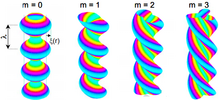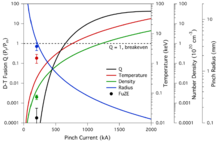|
Zap Energy
Zap Energy is an American company that aims to commercialize fusion power through use of a sheared-flow-stabilized Z-pinch. The company is based near Seattle with research facilities in Everett and Mukilteo, Washington.[1] The company aims to scale their technology to maintain plasma stability at increasingly higher energy levels, with the goal of achieving scientific breakeven and eventual commercial profitability.[2][3][4] The conceptual basis for the technology was developed at the University of Washington led by Uri Shumlak. Zap Energy formed following the positive initial results achieved by the FuZE device as part of ARPA-E's ALPHA program. The company was co-founded by British entrepreneur and investor Benj Conway (President, CEO), together with technologist Brian A. Nelson (Chief Technology Officer) and physicist Uri Shumlak (Chief Science Officer).[5] Sheared-flow-stabilized Z-pinch fusion The pinch effect relies on the fact that a current flowing in a conductor produces an inward-directed force, squeezing the conductor. In the case of a fusion device, the conductor is a plasma of the fusion fuel. The current is induced either using an external magnet, or directly applied using electrodes in the reaction chamber. The device's relative simplicity led many researchers around the world to build pinch systems. In early experiments, pinch systems were found to be unstable and the plasma was quickly forced into the walls of the reaction chamber, cooling it so that fusion does not occur. This led to the development of stabilized pinch machines, most notably the UK's ZETA. At first it appeared these designs were free from the instabilities of the earlier devices. However, further investigation showed that new "microinstabilities" were just as effective at destroying confinement as the earlier, larger, instabilities had been. With no obvious solution to these new class of problems, major research on the classic pinch devices ended by the early 1960s. The idea of using the flow of the plasma as an additional stabilizing force emerged in the 1990s. In this concept, the pinch is developed such that the plasma flows at different speeds as one moves out from the center of the plasma column, with the outer layers being about ten times as fast as the center.[6] As the magnetic field created by the pinch current is a function of both the density and speed of the charges, this causes the resulting pinch field to be non-linear across the plasma column. This surpasses the growth rate of the kink, sausage and interchange instabilities. The exact conditions that need to be reached to stabilize the pinch is an open area of research.[7][8] HistoryZap Energy's technical origins rely on the work of Dr. Uri Shumlak at the University of Washington, starting in 1995. The university built three experimental machines to test the flowing pinch:
The Shumlak lab developed custom tools to measure their plasmas.[13] Zap Energy was founded in 2017 as a spin-off from the FuZE (Fusion Z-pinch Experiment) research team at the University of Washington and collaborations with researchers from Lawrence Livermore National Laboratory.[14] Zap Energy then built a next generation fusion core, FuZE-Q (2021–present at Zap Energy). Zap achieved their first fusion reaction as a company in 2018,[15] but in November 2021, Livermore National Laboratory provided an independent and more precise measurement of neutron production inside the flowing pinch, proving that the machine can do fusion with deuterium fuel.[16] The effort was led by ARPA-E, where the agency organized fusion teams to support private fusion companies.  From 2015 to 2020, a series of U.S. Department of Energy grants enabled the team to test their sheared-flow-stabilized Z-pinch reactor at progressively higher energy levels.[18][19][20][21] In July 2020, Zap Energy raised $6.5 million in Series A funding.[22] In May 2021 Zap closed $27.5 million in Series B funding including from Addition, Energy Impact Partners, Chevron Technology Ventures and Lowercarbon Capital.[23] [5][24] Chevron's financing was the first investment in fusion energy by a major U.S. oil company.[25][26] In June 2022, Zap Energy announced first plasmas in their breakeven device (FuZE-Q) and a $160 million Series C raise backed by Lowercarbon Capital, Bill Gates's Breakthrough Energy Ventures, Shell PLC, Valor, DCVC, Energy Impact Partners, Chevron and others.[27][28] In October 2022, the Centralia Coal Transition Energy Technology Board awarded a $1 million grant to Zap Energy to fund the costs of assessing the feasibility of constructing a Zap fusion energy pilot plant at the site of the TransAlta Big Hanaford gas power plant.[29] In May 2023, Zap Energy was one of eight companies chosen for the United States Department of Energy Milestone-Based Fusion Development Program.[30][31] In June 2023, Zap Energy secured significant new repetitive pulsed power manufacturing capabilities by acquiring the liquidated assets of ICAR.[32] Also in June, Zap Energy was selected as a World Economic Forum Technology Unicorn, valued at more than one billion USD.[33] In April 2024, Zap Energy published a research paper showing that FuZE had demonstrated 1-3 keV plasma electron temperatures — (11 to 37 million degrees C), the simplest, smallest, and lowest cost device to do so.[34] In October 2024, the company announced that it closed a $130 million Series D and had begun operating a platform called Century to do integrated tests of power plant relevant technologies like repetitive pulsed power and liquid metal walls.[35] Design The Zap Energy reactor is a pulsed power system with no external magnets.[1][36][12] The machine is a ~2 meter long metal tube with a cathode running halfway down the middle. A voltage is applied between the central cathode and the grounded wall. Fusion fuel is puffed in the back of the machine, which ionizes due to Paschen breakdown, creating a plasma.[17] This plasma sweeps forward and assembles into a ~50 cm long flowing pinch in the gap between the cathode and the wall. TestingZap Energy has outfitted these machines with tools to measure the performance of the flowing pinch. Among them includes:
Other diagnostic tools have been used to measure the pinches, many in partnership with experimenters from national laboratories. Scaling up Zap Energy argued that the rate of fusion in a flowing pinch scales as the pinch current to the 11th power[39][40][41] and that because of this, all that is needed to generate net power from a flowing pinch is higher current. However, this scaling model is based on adiabatic plasmas and that model fails to capture all real-world behavior.[citation needed] Critics have pointed out that higher currents could introduce drift instabilities and shockwaves that could tear the plasma apart.[41] In the case of drift waves, the (+) ions and (-) electrons would move at different speeds because of their mass differences, and this would disrupt the plasma. Shockwaves could form during the pinch assembly process. When the plasma sweeps together at high speeds, the two plasma waves could form a shockwave at higher speeds. Finding other ways to form the pinch plasma are possible solutions to this problem. Supporting simulations have argued that to reach net power ~650 kiloamps (kA) of current is needed through the flowing pinch. As of late 2021 the company was testing with currents reaching 500 kA.[42] DeviceZap Energy proposed to surround the pinch with a molten metal blanket to absorb the energetic neutrons coming off the pinch. The blanket would convert the fusion energy to heat, which could in turn drive a steam turbine. This approach is similar to those proposed by First Light Fusion, General Fusion, and several others. ChallengesThe higher pinch currents that are needed for scale-up introduce the possibility of electrode melting and electrode erosion. This kind of erosion has been researched extensively within the field of spacecraft electric propulsion. In 2021, Zap's cathodes were made from copper coated with Tungsten carbide, which has a maximum melting point of 3,103 kelvin.[43] Materials like graphene are a possible solution. The machines could be built with bigger spot sizes, active cooling or another work-around. Another critique is that the volume of plasma inside the narrow pinch beam is relatively small when compared to fusion machines such as magnetic mirrors, tokamaks or other fusion approaches. This caps the amount of fusion fuel, and subsequently, the amount of energy that can be made in a flowing pinch. Higher shot rates, multiple machines, and longer and wider pinch beams are all possible solutions. See alsoReferences
External links |
||||||||||||||||

